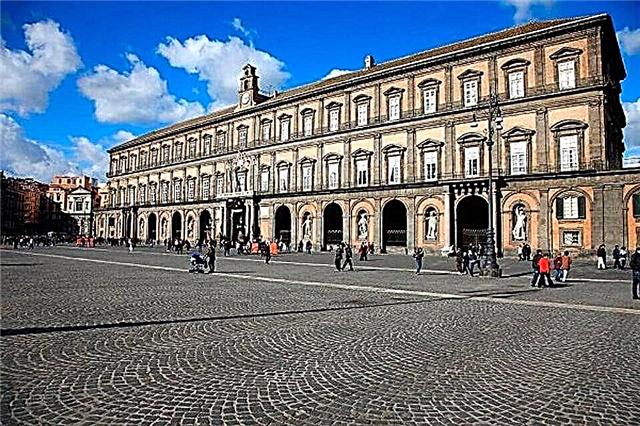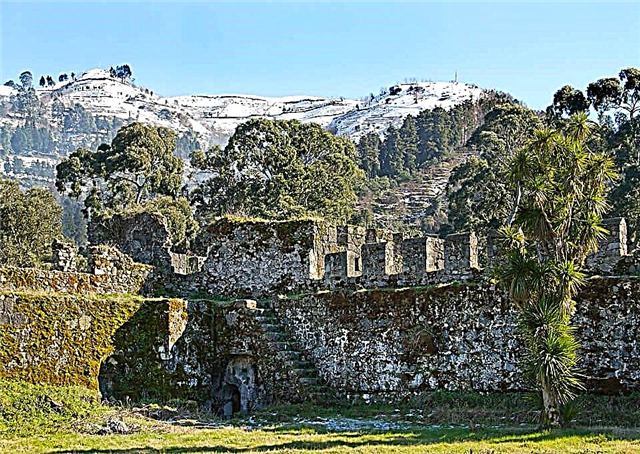Address: Germany, Munich
Start of construction: 1468 year
Completion of construction: 1525 year
Architect: Jörg von Halsbach
Height: 100 m
Coordinates: 48 ° 08'18.9 "N 11 ° 34'24.5" E
Content:
Short description
Not far from Munich's Marienplatz square is the main cathedral of the capital of Bavaria - Frauenkirche. The official name of the tallest cathedral in Munich is the Cathedral of the Blessed Virgin Mary.
Surprisingly, in 2004, at a meeting, the city authorities passed a rather controversial bill, according to which in an ultramodern city, famous for its research institutes and museums, it is forbidden to erect buildings that would be higher than the Frauenkirche.

Cathedral from a bird's eye view
The height of the cathedral, built in the Gothic style, is "only" 99 meters. Naturally, this figure cannot be called small, but it limits the construction of huge skyscrapers and office buildings in the city. What is the reason for this attitude of the authorities towards the Frauenkirche, what is so unusual about this cathedral? It's no secret that many travel agencies call the Frauenkirche the symbol of Munich and recommend to all guests of the city to visit this attraction without fail. Naturally, the Frauenkirche certainly can interest historians, connoisseurs of architectural and cultural monuments. Its long history and close connection with the legendary Witttelsbach dynasty, which once ruled Bavaria for 700 years, is certainly noteworthy.
Many guides living in Munich, telling their excursion groups about the Frauenkirch, quite often speak of the cathedral with some degree of skepticism. The fact is that the majestic cathedral, which is the tallest building in Munich, does not delight the native inhabitants of the city. The Wittelsbach family is "to blame" for this state of affairs, which, by the way, are highly respected in Bavaria, and the last descendant of this dynasty still lives at the expense of the state in the luxurious Nymphenburg palace.

View of the Cathedral from the New Town Hall
It was the founders of this dynasty who made the Frauenkirche a cathedral for the mighty of this world, and by and large, turned it into a kind of family crypt. True, this is already a story, which should be dwelt on a little below.
Frauenkirche Cathedral - history
As mentioned above, the Wittelsbach dynasty wanted to create a cathedral in which they could turn to God, and where they would find eternal rest. The first stone in the construction of the cathedral, which it was decided to build in the Gothic style, was laid in 1468. The project of the building was developed by the famous at that time architect Jörg von Halspach, who owns the words that the building in the capital of Bavaria "was built in the style of uncompromising Gothic, where there is nothing superfluous."
Frauenkirche Cathedral was built of bricks by 1494... During the opening ceremony, the church was consecrated as well. To be fair, it is worth noting that in 1494 the cathedral was not fully finished: its main architectural details - the domes on the towers, were completed in 1525. Since the middle of the 16th century, the Frauenkirche cathedral could have been called a secular cathedral; ordinary Munich residents rarely looked into it. As you know, the church should not obey the politicians and government of the country, and the Frauenkirche has become a kind of symbol known in Bavaria under the name: "the union of the throne and the altar."

View of the cathedral towers
After the first consecration, the cathedral could accommodate more than 20 thousand people. When the towers were erected, the capacity of the Frauenkirche Cathedral dropped to 12,000. After the Second World War, no more than 4 thousand people can listen to sermons in the church. All seats, as in many Catholic churches, are seated. It is worth noting that during the allied offensive against Munich, the Frauenkirche cathedral was damaged. The damage done, however, cannot be called significant. All items of interior decoration, tombs and valuable relics were not damaged. The restoration of the Frauenkirche Cathedral after World War II took place in record time. How could it be otherwise in the case of the temple, which is called "the union of the throne and the altar"? So it has remained to this day.
Frauenkirche cathedral - architecture
No modern architect can say that the facades of the cathedral do not evoke admiration for the Gothic style. Majesty, strict lines and, one might even say, some kind of chilling beauty, can be seen in every detail of the building. Despite the facade of the building, the interior of the temple disappoints many tourists. “This temple is kind of wretched”, “It’s not cozy and cold here”, “Probably we were not in a Catholic church” - these words are often uttered by many guests of Munich, who for the first time crossed the threshold of the symbol of the capital of Bavaria, the Frauenkirche Cathedral.

Facade of the cathedral
As mentioned above, even the indigenous people of the city do not favor this main attraction with their attention. The asceticism of the interior decoration, the arrogant attitude of the clergy towards believers, cannot attract the flock to the walls of the cathedral. During Sunday services on benches designed for 4,000 people, it will be difficult to count 80 parishioners. During the evening services, the Frauenkirche is practically empty: only 10-15 elderly women listen to prayers ascending to God. They only come here because they live in a shelter near the cathedral.
Despite all of the above, it is from this cathedral that numerous broadcasts of services dedicated to the most significant Catholic holidays are conducted. The Frauenkirche cathedral ceremonial can be called an accountant, director, screenwriter and stage director. In addition, he arrogantly claims that it is Frauenkirche Cathedral should be a role model for all Catholic churches... “The interior of the temple is not a circus stage, where everything should be painted with bright colors. Mass, not clowning, it cannot be shortened, during it you need to sit and listen in complete silence, ”- said in an interview with the ceremonial Anton Heckler. It was he who became the first minister of the Catholic Church who meticulously calculated on a personal computer the amount necessary for the communion of parishioners. By the way, the officially registered parish of the Frauenkirche has less than 400 people.

Main entrance to the cathedral
The close relationship of the Frauenkirche cathedral with power, which has lasted for more than 400 years, repels young people. Of the entire parish, there are less than 30 parishioners under the age of 18. It cannot be otherwise in the cathedral, where in front of the main altar there is a huge tombstone of King Ludwig of Bavaria, which completely closes the main place in the temple. In addition, the flag of Bavaria was erected over the tombstone: the banner almost completely hides the throne from the flock. At one time, Maximilian I decided to erect a strange-looking monument in the Frauenkirche cathedral, on which skulls and knights ready for battle were depicted. This monument was supposed to symbolize the tomb of the Wittelsbachs. Maximilian I was one of those politicians who understood how beneficial it was to unite the government and the church. He did not even hide his views, and erected a triumphal arch over the frightening dark monument. This arch in the Frauenkirche temple was supposed to show believers a close and inextricable connection between earthly and heavenly power.
After reading all of the above, many people whose paths will lead to Munich may think that the Frauenkirche Cathedral is not worthy of attention. However, this is not at all the case.After walking around Marienplatz and visiting its many attractions and boutiques, be sure to stop by the Frauenkirche.

View of the south tower of the cathedral from Liebfrauenstrasse
Firstly, such a sharp contrast cannot be found anywhere else in the world, and secondly, it would be an unforgivable mistake not to photograph the external facade of the cathedral, built in the style of “uncompromising Gothic”. Connoisseurs of music and choral singing will be especially interested in the acoustics of this unique architectural structure. Alas, it is impossible to listen to Bach's music there, the tempo of his works is too fast, the huge space of the room merges into a single hum. In one of the interviews of the Precentor Frauenkirche, published in a Munich newspaper, it is said that "Bach in the cathedral hits hard on the ears." You can appreciate all the charm of choral singing or music only by the Mass of Wolfgang Mozart or the chorales ascended to God, dating back to the Gregorian era.
You can find many notes about the Frauenkirche Cathedral in periodicals, and many television programs have been filmed about it. The connection between the powers of "earthly and heavenly" is too close in this amazing and truly unique cathedral, built not for the people, but for the mighty of this world. It was in one of the magazines that the saying of an old woman who was living out her days in a shelter near the Frauenkirche was quoted. She said that her mother quite often repeated the proverb, well-known in the post-Soviet space: "Be simple and people will certainly reach out to you."

Cathedral chimes
A 96-year-old grandmother, left without relatives, clarified that this proverb is suitable not only for people, but also for the nearby Frauenkirche cathedral. Only time will tell whether the authorities will heed the words of the elderly man, uttered back in 2006. By the way, the ban on the construction of buildings in Munich above the Frauenkirche is temporary and can be lifted at any time.











